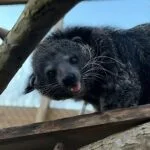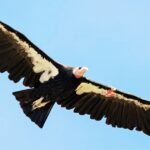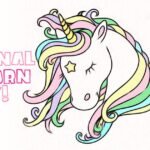Discovering the majestic creatures of the animal kingdom is a fascinating experience, and one of the most striking features that some of them possess are their long and impressive horns. These magnificent creatures have developed to have horns that serve different purposes, such as defending themselves, attracting mates, and establishing dominance in their respective environments.
Here are 15 animals with the longest horns:
The Ankole-Watusi:
This African bovine is known for its gigantic horns that can reach up to 8 feet long. These horns are used to regulate body temperature and are also a status symbol for the cattle owners.
The Ankole-Watusi is an African bovine that is well known for its gigantic horns. These impressive horns can grow up to 8 feet and are used for regulating body temperature, as well as a status symbol for the cattle owners. The Ankole-Watusi is also known for its unique appearance, with a sleek and muscular body, and distinctive long and pointed ears.
This breed of cattle is highly valued by local communities in Africa for its milk, meat, and hide. The Ankole-Watusi is a remarkable animal that has adapted to its environment over time, making it an important part of African culture and heritage.
The Texas Longhorns:
These cattle are known for their iconic curved horns, which can grow up to 7 feet. These horns were once used as weapons for defense and are now a popular sight at rodeos and western-themed events.
The Texas Longhorns is a breed of cattle that is famous for its iconic curved horns. These impressive horns can grow up to 7 feet and are used for self-defense and to establish dominance within the herd. The Texas Longhorns is a hardy breed that has adapted well to the harsh and rugged terrain of Texas, where they are primarily raised.
They are known for their resistance to diseases, low maintenance requirements, and ability to survive in harsh environments. Besides their practical uses, Texas Longhorns are also a popular sight at rodeos and western-themed events, where their impressive horns are showcased for entertainment. The Texas Longhorns is a symbol of American heritage and a testament to the resilience and adaptability of livestock in the face of changing environments.
The Greater Kudu:
This antelope from East Africa has long, spiraling horns that can grow up to 6 feet long. The males use their horns to compete for mating opportunities.
The Greater Kudu is a type of antelope found in eastern and southern Africa. It is known for its elegant and spiraled horns, which can grow up to 6 feet in males. These impressive horns are used to attract mates and establish dominance over other males during the breeding season. Besides their physical beauty, Greater Kudus are also valued for their meat and hides.
They are primarily herbivores and feed on leaves, shoots, and fruits. Greater Kudus are solitary animals that prefer to live in woodland areas where they can blend in with their surroundings. They are a symbol of the natural beauty and diversity of African wildlife and a reminder of the importance of conservation efforts to protect endangered species.
The Saiga Antelope:
This critically endangered species native to Russia and Kazakhstan has a unique-looking nose and curved horns that can reach up to 2 feet.
The Saiga Antelope is a unique and critically endangered species that is native to the grasslands of Eurasia. One of the most striking features of the Saiga Antelope is its distinctive nose, which is long and tubular, and helps to filter out dust and regulate body temperature in the extreme temperatures of its habitat. The male Saiga Antelope also has long and curved horns that can grow up to 10 inches.
Unfortunately, due to habitat loss and poaching, the Saiga Antelope has experienced a significant decline in population over the last few decades. Conservation efforts are being made to protect and preserve this unique species, but much work still needs to be done to ensure their survival. The Saiga Antelope is a reminder of the fragility of the natural world and the importance of taking action to protect endangered species from extinction.
The Bighorn Sheep:
This North American sheep is known for its massive curved horns, which can weigh up to 30 pounds and are used in head-butting contests for mating rights.
The Bighorn Sheep is a species of wild sheep found in North America, known for its distinctive large and curved horns that can weigh up to 30 pounds. The male Bighorn Sheep use their impressive horns to establish dominance over other males during breeding season, while the females use them for self-defense against predators.
Bighorn Sheep live in rugged terrain and are well adapted to their harsh environments, with specially designed hooves that allow them to climb steep and rocky mountains. They are primarily herbivores and feed on grasses and shrubs. Despite their tough exterior, Bighorn Sheep have faced significant population declines due to habitat loss, disease, and overhunting. Conservation efforts are underway to protect and preserve these magnificent animals, and their impressive horns serve as a reminder of their importance as a symbol of North American wilderness.
The Addax:
This antelope from the Sahara Desert has long, twisted horns that can grow up to 4 feet. These horns are used for self-defense against predators and as a status symbol during mating season.
The Addax is a critically endangered species of antelope that is native to the Sahara Desert in Africa. Known for its impressive spiral horns, the male Addax can grow up to 3 feet. These unique horns are used for self-defense and to establish dominance within the herd during mating season.
The Addax is a desert-adapted species, with specialized hooves that allow it to navigate through the harsh terrain of the Sahara. Unfortunately, the Addax has faced significant population decline due to habitat loss and overhunting. Conservation efforts are being made to protect and preserve this rare and iconic species, but much work still needs to be done to ensure their survival. The Addax is a symbol of the fragility of desert ecosystems and the importance of conservation efforts to protect endangered species.
The Arabian Oryx:
This antelope from the Arabian Peninsula has long, thin horns that can grow up to 3 feet. These horns are used for self-defense and also to dig for food during harsh desert conditions.
The Arabian Oryx is a species of antelope native to the Arabian Peninsula. It is known for its distinctive long, straight horns that can grow up to 3 feet. These impressive horns are used for self-defense and to establish dominance during mating season.
The Arabian Oryx is a desert-adapted species that can survive for long periods without water, and has specialized hooves that allow it to navigate through the sandy terrain of the desert. The Arabian Oryx was once extinct in the wild, but conservation efforts have successfully reintroduced the species to its natural habitat. The Arabian Oryx is a symbol of the importance of conservation efforts to protect endangered species and the natural beauty and diversity of desert ecosystems.
The Gemsbok:
This African antelope has long, straight horns that can grow up to 4 feet. These horns are used for self-defense and as a symbol of status during mating season.
The Gemsbok is a species of antelope that is native to the arid regions of Southern Africa. It is known for its striking appearance, with long and straight horns that can grow up to 3 feet. These impressive horns are used for self-defense against predators and to establish dominance during mating season. The Gemsbok is a desert-adapted species that can survive in harsh environments with limited water and vegetation.
It is well adapted to conserve water and can live for long periods without drinking. The Gemsbok is a social animal that lives in herds, and they are primarily herbivores, feeding on grasses and leaves. The Gemsbok is a symbol of the natural beauty and diversity of African wildlife, and a reminder of the importance of conservation efforts to protect endangered species and their habitats.
The Water Buffalo:
This Asian bovine has long, curved horns that can grow up to 5 feet. These horns are used for self-defense and to establish dominance over other males in the herd.
The Water Buffalo is a large and powerful bovine species that is native to Southeast Asia. It is known for its curved and massive horns that can grow up to 5 feet. These impressive horns are used for defense against predators and during dominance displays between males. The Water Buffalo is well adapted to its wetland habitat and can survive in harsh environments with limited vegetation.
It is an important domesticated animal that is widely used for agriculture, transportation, and as a source of milk, meat, and leather. The Water Buffalo is also an iconic animal in many Southeast Asia cultures, where it is celebrated in art and folklore. Despite their importance to human societies, Water Buffalo populations are threatened by habitat loss and overhunting. Conservation efforts are being made to protect and preserve this species, and their impressive horns serve as a reminder of the importance of preserving biodiversity and the cultural heritage of the region.
The Markhor:
This wild goat from Pakistan and Afghanistan has long, corkscrew-like horns that can grow up to 5 feet. These horns are used for self-defense and to attract mates.
The Markhor is a species of a wild goat that is native to the mountainous regions of Central Asia. It is known for its impressive spiral horns that can grow up to 5 feet. These unique horns are used for self-defense against predators and during dominance displays between males. The Markhor is a skilled climber and is well adapted to its rugged habitat. It is primarily a herbivore, feeding on grasses, leaves, and other vegetation.
The Markhor is an important cultural symbol in many Central Asian societies, and its image is often used in art and traditional clothing. Unfortunately, the Markhor population has been severely threatened by habitat loss, overhunting, and poaching. Conservation efforts are being made to protect and preserve this species, and their impressive horns serve as a symbol of the importance of preserving biodiversity and the cultural heritage of the region.
The Scimitar Oryx:
This antelope from North Africa has long, curved horns that can grow up to 4 feet. These horns are used for self-defense and as a status symbol during mating season.
The Scimitar Oryx is a species of antelope that is native to the arid regions of North Africa. It is known for its long, curved horns that can grow up to 4 feet. These impressive horns are used for self-defense against predators and during dominance displays between males. The Scimitar Oryx is a desert-adapted species that can survive in harsh environments with limited water and vegetation.
It is well adapted to conserve water and can live for long periods without drinking. Unfortunately, the Scimitar Oryx population has been severely threatened by habitat loss, overhunting, and poaching. Conservation efforts are being made to protect and preserve this species, and successful reintroduction programs have been carried out in some areas. The Scimitar Oryx is a symbol of the importance of conservation efforts to protect endangered species and the natural beauty and diversity of desert ecosystems.
The Yak:
This bovine from the Himalayas has long, curved horns that can grow up to 3 feet. These horns are used for self-defense and to establish dominance over other males in the herd.
The Yak is a large, shaggy-haired bovine species that is native to the mountainous regions of Central Asia. It is known for its impressive horns that can grow up to 3 feet. These sturdy horns are used for defense against predators and during dominance displays between males.
The Yak is well adapted to its harsh and snowy habitat, with a thick coat of fur that keeps it warm in cold temperatures. It is an important domesticated animal that is widely used for transportation, as a source of milk, meat, and wool, and as a pack animal for high-altitude expeditions.
The Yak is also an important cultural symbol in many Central Asian societies, where it is celebrated in art and traditional clothing. Unfortunately, Yak populations are threatened by habitat loss, overgrazing, and climate change. Conservation efforts are being made to protect and preserve this species, and their impressive horns serve as a reminder of the importance of preserving biodiversity and the cultural heritage of the region.
The Muskox:
This Arctic mammal has long, curved horns that can grow up to 4 feet. These horns are used for self-defense against predators and as a symbol of status during mating season.
The Muskox is a large and sturdy bovine species that is native to the Arctic regions of North America and Greenland. It is known for its curved and massive horns that can grow up to 3 feet. These impressive horns are used for defense against predators and during dominance displays between males.
The Muskox is well adapted to its harsh and snowy habitat, with a thick coat of fur that can protect it from extreme cold temperatures. It is primarily a herbivore, feeding on lichens, mosses, and other vegetation that can be found in the tundra. The Muskox is an important cultural symbol in many indigenous communities, where it is celebrated in art and folklore.
Unfortunately, Muskox populations have been severely threatened by hunting and habitat loss. Conservation efforts are being made to protect and preserve this species, and their impressive horns serve as a reminder of the importance of preserving biodiversity and the cultural heritage of the region.
The Jacob Sheep:
This domesticated sheep from England has four horns, two of which can grow up to 2 feet. These horns are used for self-defense and as a distinctive feature of the breed.
The Jacob Sheep is a rare and ancient breed of domesticated sheep that is native to the British Isles. It is known for its distinctive and impressive horns that can grow up to 2 feet and form a distinctive spiral pattern. These unique horns are used for defense against predators and during dominance displays between males.
The Jacob Sheep is a hardy and adaptable breed that is well suited to living in a variety of environments, including rugged terrain. It is primarily kept for its wool, meat, and milk, and has become a popular breed for small-scale farming and conservation grazing. The Jacob Sheep is an important cultural symbol in the British Isles, and its image can be found in art, literature, and folklore.
Despite being a rare breed, the Jacob Sheep has seen a resurgence in popularity and conservation efforts are being made to ensure its survival and genetic diversity. Its impressive horns serve as a reminder of the importance of preserving heritage breeds and the cultural traditions associated with them.
The Wildebeest:
The wildebeest is an African antelope that also possesses long and curved horns. These horns can grow up to 3 feet and are used for self-defense against predators. Wildebeests are known for their annual migration, which is one of the largest animal migrations in the world. During this migration, millions of wildebeests travel across the Serengeti Plains in search of food and water.
Their horns help them navigate through this harsh terrain and protect themselves from predators such as lions and hyenas. The wildebeest is truly a remarkable animal and a testament to the resilience and adaptability of nature.










